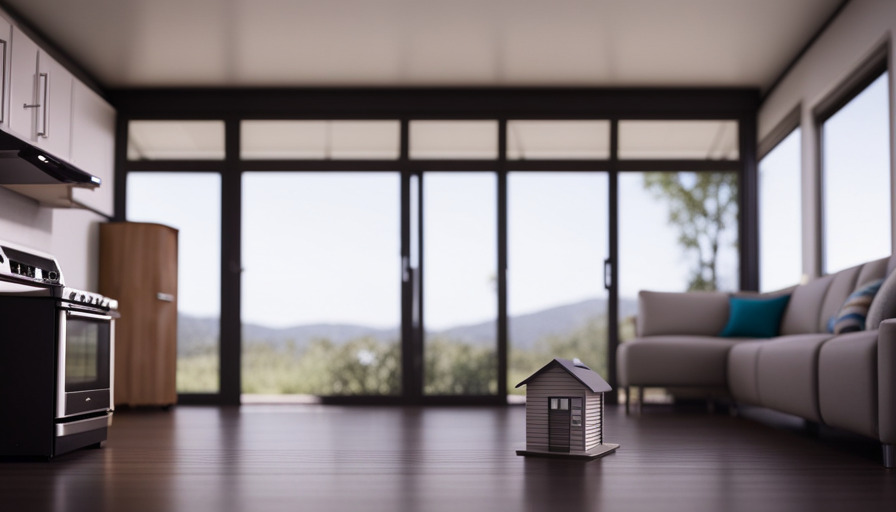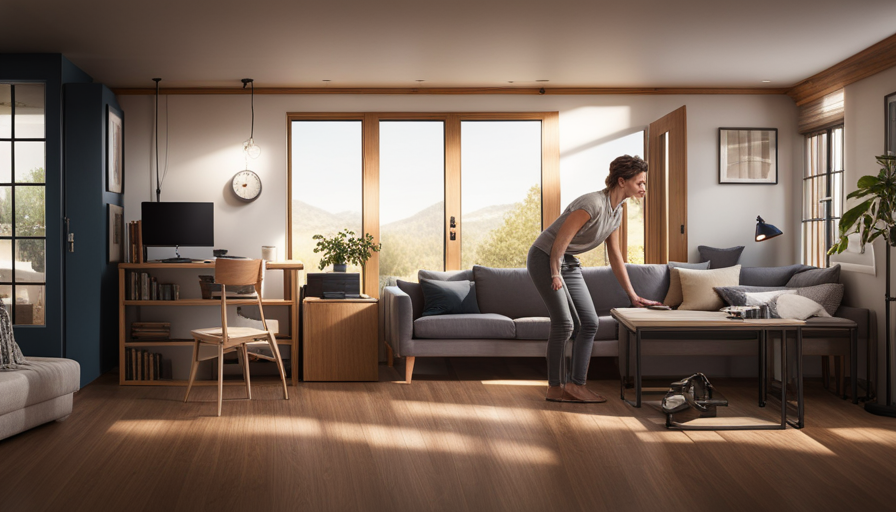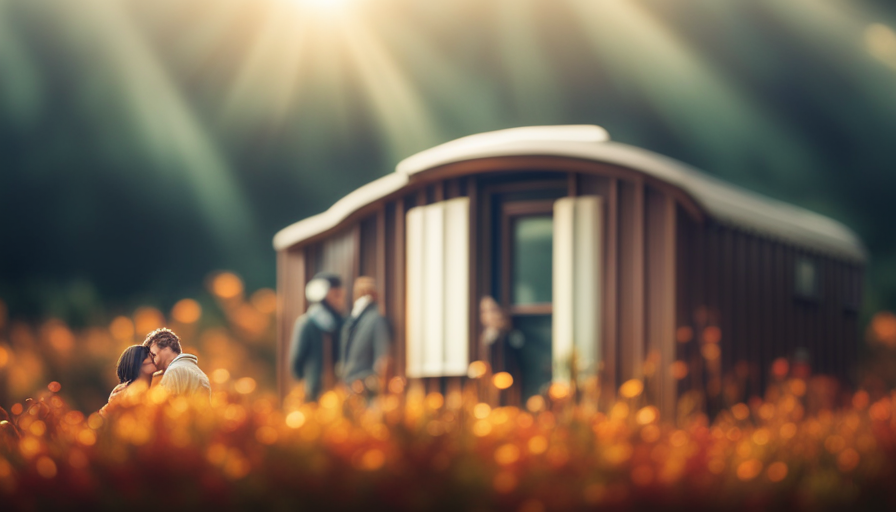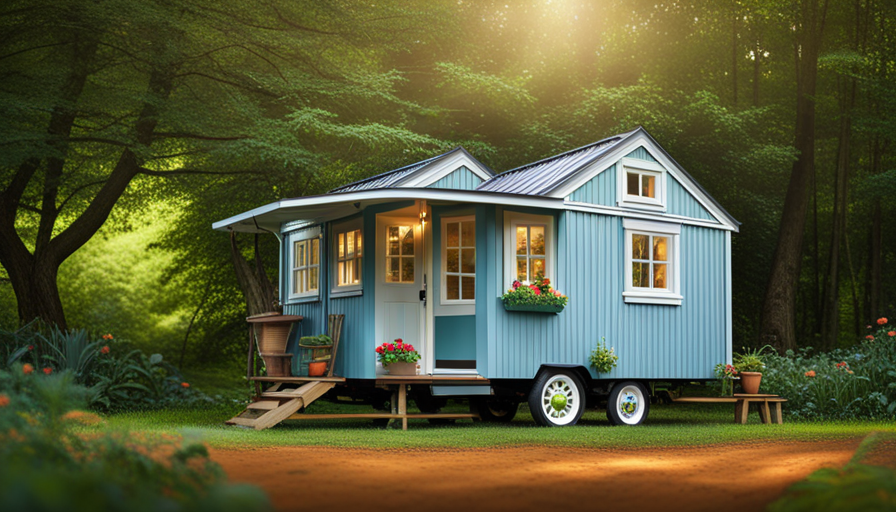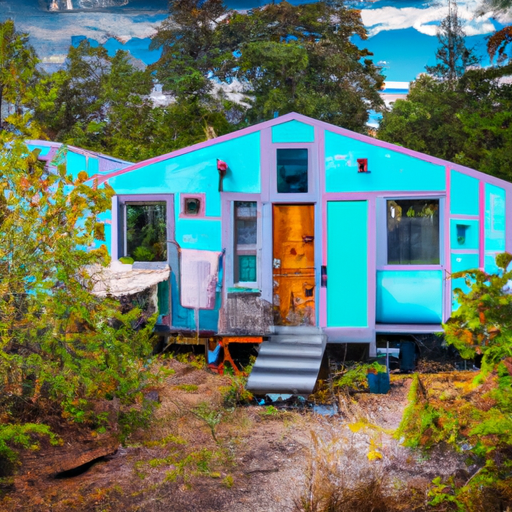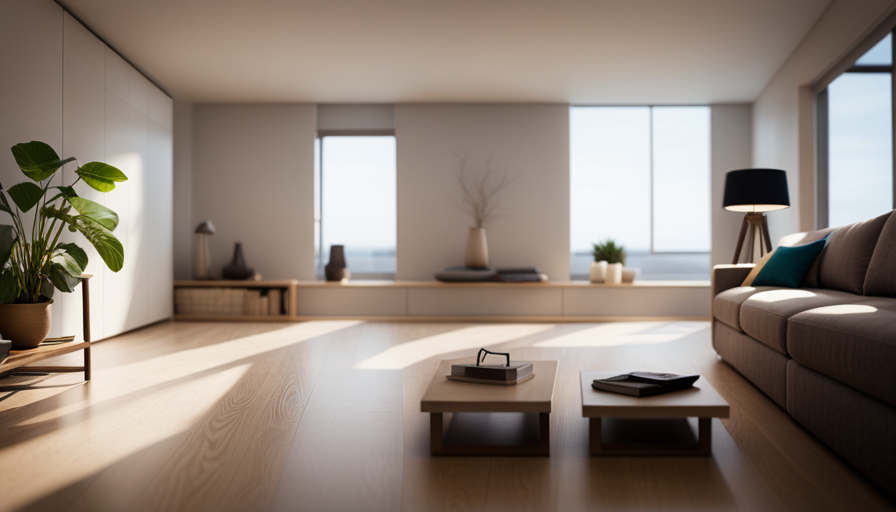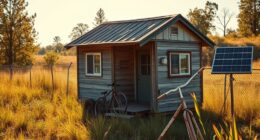While browsing the internet for small home designs, I unexpectedly stumbled upon an interesting idea – a prefabricated tiny house that measures 400 square feet. Intrigued by the idea of minimalist living, I became curious about the cost of such an unconventional home.
In this article, we will delve into the various factors that contribute to the overall cost of a 400 square feet prefabricated tiny house. From the materials used in construction to the labor costs, size and design features, location and site preparation, plumbing and electrical systems, off-grid options, financing and insurance, maintenance, and long-term costs, and even considerations for DIY builders.
By examining each of these aspects, we will gain a comprehensive understanding of what it takes to bring a 400 square feet prefabricated tiny house to life and the financial investment it entails. So, let’s embark on this cost analysis journey and unravel the secrets behind the price tag of these charming miniature residences.
Key Takeaways
- The cost of a 400 square feet prefabricated tiny house is influenced by factors such as the materials selected for durability and cost-effectiveness, eco-friendly materials chosen to minimize environmental impact, and the use of lightweight and sturdy materials like steel and engineered wood.
- Labor costs for a tiny house project are influenced by the complexity of design, skill level of laborers, and construction timeline. Simple designs require less time and effort, resulting in lower labor costs, while larger homes require more materials and construction time, leading to higher expenses.
- Design features and customization options can affect labor costs. Additionally, location selection impacts accessibility, proximity to amenities, and environmental impact, with consideration for solar energy, wind power, and waste management options.
- The selection of interior finishes and appliances, such as flooring options (hardwood, laminate, vinyl, tile) and countertop choices (quartz, granite, laminate), can contribute to the overall expense of a 400 square feet prefabricated tiny house. Additionally, the choice of energy-efficient appliances and off-grid power options can impact the cost.
Materials Used in Construction
The materials used in constructing a 400 sq ft prefabricated tiny house are carefully selected to ensure durability and cost-effectiveness. Prefabricated construction has become increasingly popular due to its efficiency and reduced construction time. In this type of construction, eco-friendly materials are often chosen to minimize the environmental impact.
One of the primary considerations when selecting materials for a prefabricated tiny house is their ability to withstand transportation and assembly. Lightweight yet sturdy materials like steel and engineered wood are commonly used. These materials not only provide structural integrity but also contribute to the overall energy efficiency of the house.
Another important aspect is the use of eco-friendly materials. These include recycled materials such as reclaimed wood, salvaged windows, and sustainable insulation made from recycled denim or cellulose. By using these materials, the environmental footprint of the construction process is minimized.
In addition to their eco-friendliness, these materials also offer cost savings. Recycled and reclaimed materials are often less expensive than new alternatives, helping to keep the overall cost of the house down. Furthermore, the use of sustainable insulation can lead to long-term energy savings, reducing utility bills for the homeowner.
Transitioning to the subsequent section about labor costs, it’s important to consider how the carefully selected materials impact the overall cost-effectiveness of the project.
Labor Costs
Labor costs for a 400 sq ft prefab tiny house are influenced by the amount of work needed to assemble and construct the home. The efficiency of labor plays a crucial role in determining the overall cost. Factors such as the complexity of the design, the skill level of the laborers, and the availability of resources can affect labor efficiency.
If the design of the tiny house is simple and straightforward, it would require less time and effort to construct, resulting in lower labor costs. On the other hand, a more intricate design with intricate details and customization options would require more labor hours, thus increasing the labor costs.
Another important factor that influences labor costs is the construction timeline. If the project has a tight deadline and needs to be completed quickly, it may require additional laborers or longer working hours, leading to higher labor costs. Conversely, if there is more flexibility in terms of the construction timeline, labor costs can be reduced.
Transitioning into the next section about ‘size and design features,’ the labor costs associated with a 400 sq ft prefab tiny house can vary depending on its size and the complexity of its design.
Size and Design Features
When considering the size and design features, you’ll find that the overall aesthetics and layout of your prefab tiny home greatly impact its labor requirements and subsequent expenses. Here are three key factors to consider:
-
Size Options: The size of your prefab tiny house is a major determinant of labor costs. Larger homes require more materials and take longer to construct, leading to higher expenses. On the other hand, opting for a smaller footprint can help reduce both construction time and costs.
-
Design Trends: The design features you choose for your prefab tiny house can also affect the labor and cost. Intricate designs or complex architectural elements may require skilled labor and additional time to complete. Conversely, simpler designs with clean lines and minimalistic features can streamline the construction process, resulting in lower labor expenses.
-
Customization Level: The extent to which you customize your prefab tiny house impacts labor costs as well. If you choose to incorporate unique or personalized design elements, it may require more time and specialized skills from the construction team, increasing the overall expenses.
Considering these factors, it becomes evident that both size options and design trends significantly influence the labor costs associated with a prefab tiny house. Moving forward, let’s explore how the location and site preparation further contribute to the overall expenses.
Location and Site Preparation
Consider the impact of where you choose to place your prefab tiny home and the necessary preparations for the site. When selecting the location for your tiny house, factors such as location accessibility and environmental impact should be taken into account. Accessibility is crucial as it determines how easily you can reach amenities, such as grocery stores, healthcare facilities, and schools. Additionally, consider the proximity to public transportation and major roads for commuting purposes. This will greatly influence your daily life and convenience.
Another important aspect to consider is the environmental impact of your chosen location. Look for a site that minimizes the disturbance of natural habitats and ecosystems. Consider the potential for solar energy, wind power, or other sustainable energy sources. Additionally, evaluate the site’s water resources and waste management options. Choosing a location that aligns with your sustainability goals can significantly reduce your ecological footprint.
Selecting the right location for your prefab tiny home is crucial for your overall well-being and sustainability. Once you’ve considered location accessibility and environmental impact, you can move on to planning the plumbing and electrical systems for your tiny house, ensuring a comfortable and functional living space.
Plumbing and Electrical Systems
To create a comfortable and functional living space, it’s crucial to ensure the plumbing and electrical systems in your prefab tiny home are well-planned and properly installed.
When it comes to plumbing installation, it’s important to consider the size and layout of your tiny house. A 400 square feet space may require a smaller water heater and plumbing fixtures compared to a traditional-sized home.
Additionally, the location of your tiny house will determine how you connect to water and sewer lines. You may need to work with a professional to ensure that your plumbing system meets local building codes and regulations.
In terms of electrical wiring, it’s essential to carefully plan the placement of outlets, switches, and lighting fixtures to optimize the functionality and aesthetics of your tiny home. With limited space, it’s important to strategically position electrical components to avoid clutter and maximize efficiency.
Hiring a licensed electrician is highly recommended to ensure that all wiring is properly installed and meets safety standards.
With the plumbing and electrical systems in place, you can move on to the next step of your prefab tiny house project: interior finishes and appliances.
Interior Finishes and Appliances
When it comes to the interior finishes of a tiny house, the cost can vary depending on the materials chosen. Factors such as the type of flooring and countertops can significantly impact the overall expense. Additionally, the price of appliances, such as kitchen and bathroom fixtures, should also be considered as they contribute to the functionality and aesthetics of the space.
It’s important to carefully consider these costs when budgeting for a tiny house project.
Cost of interior finishes, such as flooring and countertops
Choosing the perfect flooring and countertops for your tiny house will make it feel like a cozy and luxurious home. When it comes to the cost of interior finishes, it’s important to consider factors such as durability, aesthetics, and budget.
For flooring options, you can choose from materials like hardwood, laminate, vinyl, or tile. Hardwood flooring offers a timeless and elegant look, but it can be more expensive compared to laminate or vinyl. On the other hand, tile flooring is durable and easy to clean, but it may require professional installation. As for countertops, popular choices include quartz, granite, and laminate. Quartz countertops are known for their durability and low maintenance, but they can be pricey. Granite countertops offer a luxurious and natural look, but they require regular sealing. Laminate countertops are affordable and come in a wide range of colors and patterns.
In terms of cost, the table below provides a general idea of the average prices for flooring and countertop materials:
| Flooring Material | Average Cost per Sq. Ft. |
|---|---|
| Hardwood | $8 – $15 |
| Laminate | $2 – $5 |
| Vinyl | $1 – $5 |
| Tile | $5 – $10 |
| Countertop Material | Average Cost per Sq. Ft. |
|---|---|
| Quartz | $50 – $100 |
| Granite | $40 – $75 |
| Laminate | $20 – $30 |
Considering the cost of paint and cabinets, it’s important to budget for these additional expenses when planning your tiny house interior. Moving on to the next section, we’ll explore the expense of appliances, including kitchen and bathroom fixtures.
Expense of appliances, including kitchen and bathroom fixtures
Ready to give your kitchen and bathroom a touch of luxury? Let’s talk about the expense of appliances and those beautiful fixtures that’ll make your tiny house feel like a dream home.
When outfitting your tiny house, it’s important to consider the cost of appliances, including kitchen and bathroom fixtures. Here are three items that can add a touch of elegance to your tiny house:
-
Stainless steel kitchen appliances: These sleek and modern appliances not only provide functionality but also elevate the aesthetic of your kitchen space.
-
High-quality bathroom fixtures: Investing in fixtures such as a rainfall showerhead or a freestanding bathtub can create a spa-like oasis in your tiny bathroom.
-
Energy-efficient appliances: Opting for energy-saving appliances not only helps reduce your carbon footprint but can also save you money on utility bills in the long run.
By carefully considering the expense of appliances and fixtures, you can create a luxurious and functional space within your tiny house.
Now, let’s explore the next section about off-grid options to make your tiny house even more self-sustaining.
Off-Grid Options
Living off the grid in a tiny house is like embracing freedom and walking hand in hand with nature. It’s a sustainable way of living that allows you to minimize your environmental impact while enjoying a simpler lifestyle. One of the key considerations when going off-grid in a tiny house is the availability of off-grid power options. By utilizing renewable energy sources such as solar panels, wind turbines, or a combination of both, you can power your tiny house without relying on traditional electricity grids.
To help you better understand the off-grid power options available, I have created a table below:
| Off-Grid Power Options | Pros | Cons |
|---|---|---|
| Solar Panels | Clean energy source, low maintenance | Initial high installation cost |
| Wind Turbines | Reliable in windy areas, can generate more power | High installation cost, noise |
| Hybrid Systems | Combines solar and wind power, increased reliability | Higher upfront cost, maintenance |
By carefully considering these options, you can choose the off-grid power solution that best suits your needs and budget. Now that we have explored off-grid options, let’s move on to the next important aspect of building a tiny house: financing and insurance.
Incorporating off-grid power into your tiny house not only helps you live sustainably, but it also reduces your reliance on traditional energy sources. This transition sets the stage for exploring the financial and insurance aspects of building a tiny house.
Financing and Insurance
When it comes to financing a tiny house, there are several loan options available. From personal loans to RV loans, individuals have various choices to explore. It’s important to consider the interest rates, loan terms, and eligibility criteria before making a decision.
Additionally, insurance coverage for tiny houses is essential to protect against any potential risks or damages. The associated costs will depend on factors such as the value of the tiny house, location, and coverage options. It’s crucial to thoroughly research and compare insurance providers to find the best coverage at an affordable price.
Loan options for financing a tiny house
If you’re considering financing a tiny house, there are various loan options available to help you make your dream a reality. Here are some of the financing alternatives you can explore:
-
Personal Loans: You can apply for a personal loan from a bank or credit union to finance your tiny house. These loans typically have fixed interest rates and repayment terms that can range from a few months to several years.
-
RV Loans: If your tiny house meets the requirement of being classified as an RV, you can opt for an RV loan. These loans are specifically designed for mobile homes and may offer favorable terms and interest rates.
-
Construction Loans: If you plan to build your tiny house from scratch, you can consider a construction loan. This type of loan provides funds in stages as the construction progresses.
-
Peer-to-peer Lending: Another option is to explore peer-to-peer lending platforms, where individuals can borrow money directly from other individuals.
When it comes to financing a tiny house, it’s essential to research and compare different loan options to find the one that best fits your needs and financial situation.
In the next section, we will discuss insurance coverage and associated costs.
Insurance coverage and associated costs
To ensure your investment is protected, it’s important to understand the insurance coverage options available and the associated expenses. When it comes to insuring a prefabricated tiny house, there are a few key factors to consider.
First, you’ll want to determine the type of coverage you need. This can include coverage for the structure itself, liability coverage in case someone is injured on your property, and personal property coverage for your belongings inside the tiny house.
Insurance premiums for a 400 sq feet prefabricated tiny house can vary depending on factors such as the location, value of the house, and the coverage options you choose. It’s important to shop around and compare quotes from different insurance providers to find the best coverage and premiums for your specific needs.
With insurance coverage in place, you can have peace of mind knowing that your tiny house is protected.
Moving on to maintenance and long-term costs…
Maintenance and Long-Term Costs
The average long-term cost of maintaining a 400 sq ft prefabricated tiny house is surprisingly low, making it an affordable housing option for many. One of the main reasons for this is the reduced maintenance costs compared to traditional homes. Prefabricated tiny houses are designed to be low-maintenance, with durable materials and efficient systems that require little upkeep. Additionally, these homes are often built with energy efficiency in mind, which can lead to significant savings on utility bills.
To give you an idea of the potential maintenance costs, here is a table comparing the average annual expenses for a 400 sq ft prefabricated tiny house versus a traditional home:
| Maintenance Expenses | Prefabricated Tiny House | Traditional Home |
|---|---|---|
| Insurance | $500 – $1,000 | $1,000 – $2,000 |
| Repairs | $200 – $500 | $1,000 – $3,000 |
| Utilities | $500 – $800 | $1,200 – $2,000 |
| Total | $1,200 – $2,300 | $3,200 – $7,000 |
As you can see, the maintenance costs for a prefabricated tiny house are significantly lower than those for a traditional home. This affordability extends to long-term expenses as well, making it an attractive option for those looking to minimize their housing costs.
Considering the low maintenance costs and energy efficiency of prefabricated tiny houses, they are an excellent choice for DIY builders looking to create an affordable and sustainable home.
Considerations for DIY Builders
For DIY builders, there are important factors to consider when creating an affordable and sustainable home. By utilizing DIY building techniques and cost-saving strategies, you can minimize expenses and still achieve your dream tiny house.
Here are four key considerations for DIY builders:
-
Research and Planning: Before starting your project, invest time in researching various building techniques, materials, and suppliers. Planning ahead will help you make informed decisions and avoid costly mistakes.
-
Recycled and Reclaimed Materials: Incorporating recycled and reclaimed materials into your construction can significantly reduce costs. Look for salvaged wood, reclaimed windows, and second-hand appliances to save money while also minimizing waste.
-
Simple Designs: Opt for a simple and minimalist design that requires fewer materials and labor. Avoid complex architectural features that can drive up costs, and focus on functionality and efficiency instead.
-
DIY Skills and Collaboration: The more tasks you can handle yourself, the more money you can save. Learn basic construction skills and consider collaborating with other DIY builders to share resources and knowledge.
By following these DIY building techniques and cost-saving strategies, you can create an affordable and sustainable tiny house that meets your needs and budget.
Frequently Asked Questions
What are the zoning regulations and building codes for prefabricated tiny houses?
Zoning regulations and building codes for prefabricated tiny houses can vary depending on the location. It’s crucial to research and comply with local building permits and regulations before constructing a tiny house.
Some areas have specific requirements for the size, materials, and foundation of tiny houses. Additionally, some communities have dedicated tiny house communities that may have their own set of rules and regulations.
Understanding these guidelines is essential for a successful tiny house project.
Are there any restrictions on where a prefabricated tiny house can be placed or parked?
There are parking regulations and legal restrictions that determine where a prefabricated tiny house can be placed or parked. These regulations vary depending on the location and jurisdiction. It’s important to research and comply with local laws to avoid any issues.
Some areas may have restrictions on parking a tiny house on public streets, while others may require it to be placed on private property. Consulting with local authorities can help ensure compliance with these regulations.
How long does it typically take to construct a prefabricated tiny house?
The construction timeline for a prefabricated tiny house can vary depending on factors such as design complexity and customization. On average, it can take anywhere from a few weeks to a few months to complete.
As for the cost breakdown, it typically includes expenses for materials, labor, permits, and site preparation. It’s important to consider these factors when budgeting for a prefabricated tiny house project.
Are there any additional costs associated with hooking up utilities to a prefabricated tiny house?
Yes, there are additional costs associated with hooking up utilities to a prefabricated tiny house. These include the cost of connecting to the local power grid, installing a water and sewage system, and setting up internet and cable services.
Additionally, permits and inspections may be required, which can vary in cost depending on the location. It’s important to budget for these expenses when considering the overall cost of a prefabricated tiny house.
Can a prefabricated tiny house be customized or modified after it is delivered?
Yes, a prefabricated tiny house can be customized or modified after it’s delivered. There are various customization options available, such as choosing different materials, layouts, and finishes.
Additionally, post-delivery modifications can be made to add or remove features, expand the living space, or incorporate additional amenities. These options allow for personalization and flexibility in creating a unique and tailored living space.
Conclusion
In conclusion, the cost of a 400 sq ft prefabricated tiny house can vary depending on several factors. On average, the materials and labor costs can range from $30,000 to $60,000.
However, one interesting statistic to note is that according to a recent survey, over 68% of tiny house owners reported that their monthly expenses decreased after downsizing. This shows that not only can a tiny house be a cost-effective housing option, but it also has the potential to significantly reduce living expenses in the long run.
Hi, I’m Emma. I’m the Editor in Chief of Tiny House 43, a blog all about tiny houses. While tree houses are often associated with childhood, they can be the perfect adult retreat. They offer a cozy space to relax and unwind, surrounded by nature. And since they’re typically built on stilts or raised platforms, they offer stunning views that traditional homes simply can’t match. If you’re looking for a unique and romantic getaway, a tree house tiny house might just be the perfect option.
